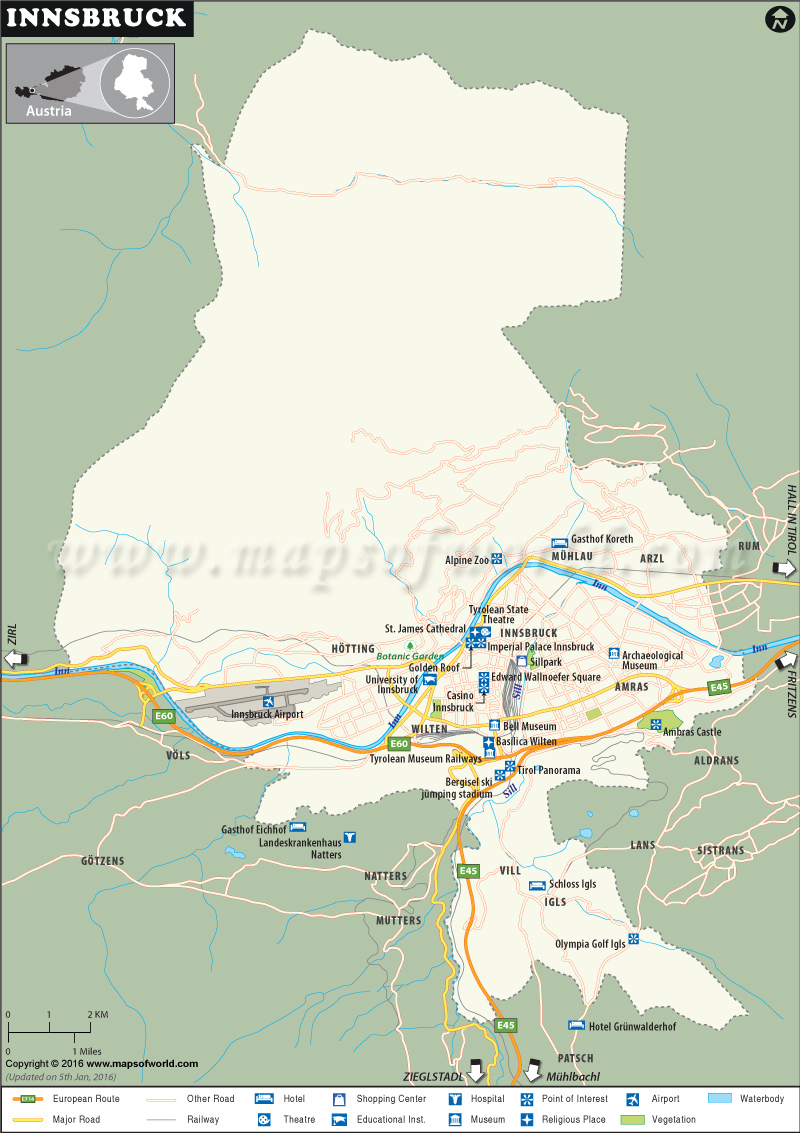Map of Innsbruck City

Innsbruck, the capital city of Tyrol is located at the western part of the Austrian nation on the Inn valley near its confluence with Wipptal or the Sill River. The valley provides an easy access to the Brennerpass from Innsbruck that is only at a distance of 30 km southward.
The city of Innsbruck is nestled between high snow peaked Aplian mountains. Innsbruck is categorized as a statutory city of the country that stretches upto 104.9 square km at official coordinates as 47°16′ N 11°23′ E. The approximate population size of Innsbruck city is about 117,916.
Archeological findings say that life was found since the early Stone Age. Only in 1429, Innsbruck became the capital of Tyrol and treated as a centre of European politics and culture.
Today majority of the Innsbruck inhabitants are the direct decedents of Tyrolean, and has much of its influence on the city’s cultural aspect. Gradually, however, there has been an influx of Turkish, North Africans, Indians, Roma, and even Chinese and Nepali. The economy and culture of Innsbruck was heavily disrupted.
The average climatic conditions of Innsbruck is around 32 °C during warmer months of June – July, whereas, in winter minimum mean temperate is faced during December January with – 13.5 °C. The annual mean precipitation is 128 mm in July.
The most attractive places Innsbruck city are:
- The Nordkette Mountain or Hafelekar (2,334 m altd.)
- Vierschanzentournee, a 4 Hills Tournament
- Innsbrucker tanzsommer
- Patscherkofel at 2,246 m from sea-level
- Southern Serles with altd of 2,718 m
- Bergsilvester (New Years Eve)
- Inn Brucke
- Festwochen der Alten Musik or Weeks of Classic Music
- Christkindlmarkt
- The famous Goldenes Dachl / Golden Roof
- Kaiserliche Hofburg
- The tomb of Emperor Maximilian I, Holy Roman Emperor
- Buildings of Altes Landhaus, Altstadt and Annasaule
- Tiroler Landestheater Innsbruck (Theatre)
- Museums of Riesenrundgemalde, Tiroler Landesmuseum, Tiroler Volkskunstmuseum, Zeughaus, Tiroler Museumsbahnen, Kaiserjagermuseum
There are many churches like Ursulinenkirche, Dom zu St. Jakob, Hofkirche, Stift Wilten
Wiltener basilica, Spitalskirche and Liebfrauenkirche and also beautiful green parklands of Alpenzoo, Rapoldipark and Schlosspark Ambras.
Among sports activity, mountain skiing is very common in resorts of Axamer Lizum, Igls, Seefeld, Tulfes and Stubai Valley. The Olympic Winter Games were also started in Innsbruck in 1964. The economy of Innsbruck concentrates on tourism and considered to be the most important source of income for the city authority.